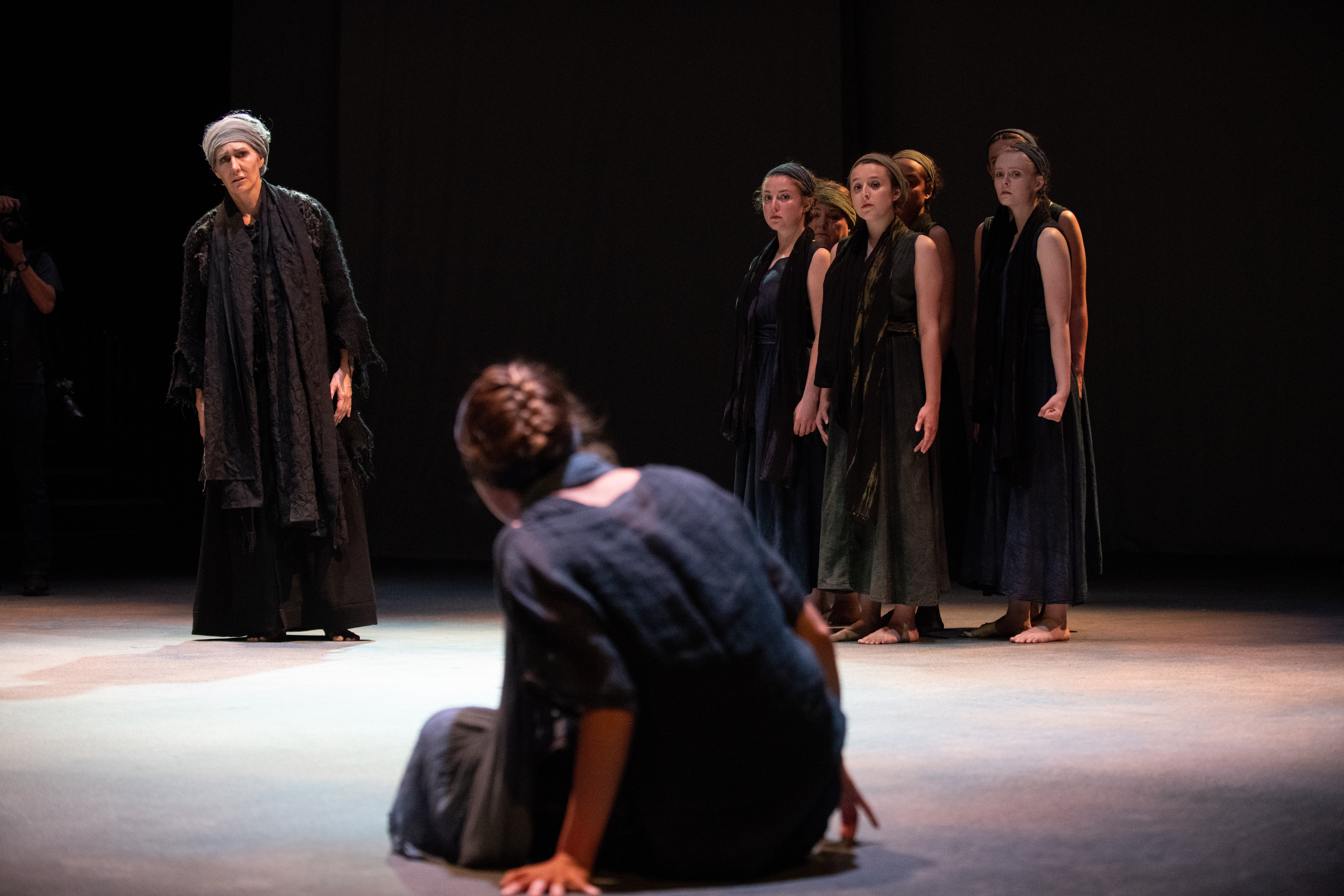In the tragic climax of “King Lear,” Lear holds the corpse of his daughter Cordelia, knowing she will never wake again: “Never, never, never, never, never.” In this Stanford Repertory Theater adaptation of Euripides’ Greek tragedies “Hecuba” and “Helen,” Hecuba gazes on the corpse of her son, Polydorus, a sight she never wished to see: “Never, never, never.” The last two “nevers” never come, and unfortunately, neither does the tragic climax.
“Hecuba/Helen” is engaging, well-designed and smoothly executed — it could be worth seeing for these virtues alone. However, despite ample opportunities presented in the original text, this production never fully lands a moment of heart-stopping, cathartic force.
In the hands of co-adapters Rush Rehm and Courtney Walsh, these two plays are not so much fused as they are juxtaposed without any attempt to unify their different tones. The first half is a more conventional tragedy, while the second part slides closer to a dark comedy. The main piece of connective tissue is Walsh herself, as both protagonists, becoming — through this double role — every woman who has ever refused to serve as a passive pawn in the games of powerful men. Aiding her is a Greek chorus of female slaves (Jennie Brick, Gianna Clark ’19, Regan Lavin ’21, Amber Dale Levine ’18, Brenna McCulloch ’20, Emma Rothenberg ’19 and Lea Claire Zawada ’18): first Trojan slaves captured along with Hecuba, then Greek slaves alongside Helen.
This group (choreographed by Aleta Hayes) dances, sings and speaks to provide context to the story and support to Walsh’s protagonists. At their best, they are storytelling personified, their movements perfectly focusing audience attention on the story being told. However, sometimes their uniform movements make it unclear where to look and end up obscuring the text and therefore the story. The same is true of the projections, executed by Nima Deghani — though visually stunning, they occasionally distract from the action occurring on stage.
The other technical elements were similarly mixed in their effects. On the plus side, Connie Strayer’s spare but effective set design used only a single central set piece (a kind of angled block) to build out the space, aided by Michael Ramsaur’s elegant and textured lighting design. Meanwhile, the emotional tone of each scene got a boost from an unearthly sound design by Michael Keck. More baffling choices included a vaguely appropriative costume for the Egyptian prophetess and almost atonal compositions for the songs in “Hecuba.”
Fortunately, the evening is full of standout performances by secondary characters. There’s an unreadable Odysseus and a hilarious Menelaus — both played by Joe Estlack — while Benoit Monin turns in two chilling performances as Talthybius and Egyptian Messenger, both witnesses to events they would rather not have seen. Shayan Hooshmand makes a pitiable ghost as Polydorus, but where he really shines is in a wordless bit of comedy as Pollux.
Still, this production seems determined to gloss over the revelatory, gut-wrenching instants that mark great tragedy. As mentioned previously, there’s Hecuba’s first sight of her son’s corpse. Though the lines that follow seem to denote great grief, we miss the thunderclap moment of recognition, and so the subsequent beats seem hollow and false. The same happens in a more comedic context in the second play: Menelaus and Helen, the long-separated couple, recognize each other, but the script bulls ahead, robbing us of that moment’s emotional impact. Euripides wrote in plenty of these electrifying turns, what Aristotle called peripeteia: the split second in which the action reverses direction, and nothing will ever be the same again. But time and time again, “Hecuba/Helen” fails to highlight them: Polyxena’s acceptance of her death, Theoclymenus’ realization that Helen is not returning, Agamemnon’s verdict between Hecuba and Polymnestor and so on.
The show runs along for two mostly engaging hours, slick and tightly planned, and one has to admire the economy of the staging to keep these plays briskly paced and under two hours. But I’ve gladly sat through four-hour stagings that ripped my guts out and showed them to me; I would have happily spent five more minutes in “Hecuba/Helen” if I could have felt more strongly the power of these tragic moments.
Contact Minh-Anh Day at mday19 ‘at’ stanford.edu.
